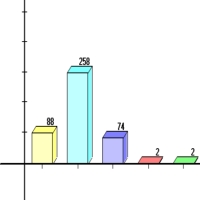"Here arises a puzzle that has disturbed scientists of all periods. How is it possible that mathematics, a product of human thought that is independent of experience, fits so excellently the objects of physical reality? Can human reason without experience discover by pure thinking properties of real things?"
-- Einstein
We finished Chapter 10 by discussing springs and then elastic collisions. We then began our discussion of Chapter 11. I continued what seems to have become a tradition: I did not get to the final section of the Chapter, §11.7 - Power.
| Here are the clicker questions we asked today |
About 70% of the class answered C: the balls reach the end of their tracks at the same time. This is not correct. The correct answer is the same as Version 1 of this question from last class: B: the ball on the curved track "wins" the race.
About half the class answered correctly C: they have the same kinetic energy. For the other half, this disappointed me. I thought this would be a straightforward application of the fact that the total work is equal to the change in kinetic energy.
Here about half the class answered correctly B: puck #2 has the greatest momentum.
It is possible to solve this problem the hard way by using Newton's 2nd Law to find the acceleration, and hence the final speeds for the two pucks, and then calculating the momentum. An easier way is to use the facts that the two pucks have the same kinetic energy and, as just discussed in class when we didi the billiards example, K = p2 / (2m). Thus the momentum of the more massive puck must be greater.
Here is the distribution of answers on this question. About 60% of the class chose B: the times are the same. This is correct in the absence of air resistance, but is not correct here. As with the previous question, one can arrive at the correct answer by directly using Newton's 2nd Law, making some reasonable assumption about the magnitude of the air resistance compared to the ball's weight, and doing a bunch o' kinematics. However using conservation of energy is a lot easier. |
 |
We know that the air resistance reduces the total mechanical energy of the ball. Thus when it strikes the ground it will be moving slower than the initial speed when we threw it up. Similarly, for any vertical height the speed of the ball on the way down must be less than the speed on the way up: it loses kinetic energy between going up and coming back down.
Since the ball's speed going up is always greater than the corresponding speed on the way down, the correct answer must be C: the time to go up is less than the time to come back down.
| We showed this Flash animation about Hooke's Law for springs. | |
| We also showed this animation about the dot product of two vectors |
| Pdf version of the PowerPoint on the side screens. | |
| Today's Journal. |
| The arrows let you jump to the previous/next class summaries. |